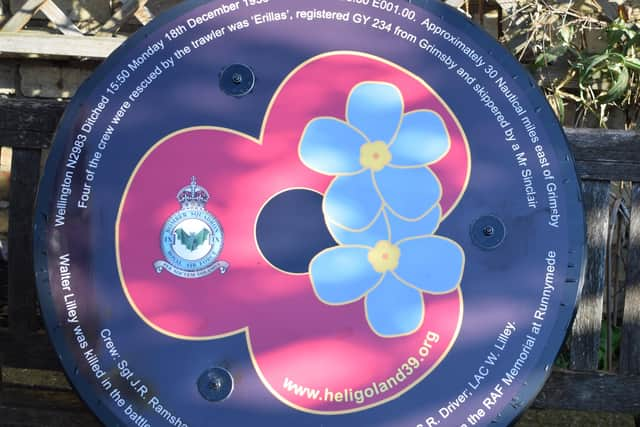Putting together the pieces of a ‘forgotten war’ off the Yorkshire coast


Alan Foster’s RAF Wellington had been shot down two months earlier, in one of the first aerial engagements of the Second World War. His family endured Christmas knowing only that he was missing in action.
The anniversary of the Battle of Heligoland Bight passed with little of the ceremony that will accompany this summer’s 80-year celebration of Churchill’s Few, in the Battle of Britain.
Advertisement
Hide AdAdvertisement
Hide AdBut strung out along the coast, a group of historians, researchers and relatives have joined forces to prevent one of the least documented chapters of its time becoming a missing piece in the wartime jigsaw.


Aircraftsman Second Class Foster, aged 18 and a year out of training as an air gunner and radio operator, was one of a crew of six who had taken off in broad daylight from RAF Mildenhall in Suffolk, with orders to attack German warships at Wilhelmshaven on the North Sea Coast. The war was little more than three months old.
His Wellington was one of 24 scrambled that morning. Only half of them made it back, and of the 59 airmen – including two Luftwaffe pilots – who died in the space of an hour, just 12 were recovered for burial on land.
When Foster’s body was eventually washed ashore, it was taken into St Nicholas’ Church, in the East Riding parish of Hollym, which served as a temporary mortuary for him. The body of one of his comrades did not wash up until May.
Advertisement
Hide AdAdvertisement
Hide Ad“It’s a forgotten history that is hardly acknowledged. I’ve spoken even to many RAF people who have never heard of it,” said Jack Waterfall, a retired farmer who lost an uncle in a Wellington in 1940, and who is among those planning to publish a book this year on the early part of the war and its legacy.
Heligoland was not just a personal tragedy for the airmen and their families, he said, but for Britain itself. The catastrophic loss of such a large part of the formation laid waste to Bomber Command’s belief, instilled in it by the former Prime Minister Stanley Baldwin, that in tight formation “the bomber would always get through”, regardless of air defences.
“This was the battle that forced them to switch from daytime to nighttime missions,” Mr Waterfall said.
“When we see Bomber Command portrayed in terms of clouds of Lancasters on night raids, it seems that they’ve forgotten about the early days. We’re trying to bring those into the public consciousness.”
Advertisement
Hide AdAdvertisement
Hide AdThe second Battle of Heligoland Bight – the first had been at sea in 1914 – was also the first air conflict of the war to be given a name. It took place during the “phoney war” that had begun in September 1939, a time in which little fighting took place on land or in the air.
Alan Foster and his comrades had set off under cloud cover but found the skies over Germany “gin clear”, according to a contemporary account. “The Luftwaffe made hay,” it added.
His port wing tanks damaged by enemy fire and losing fuel fast, Foster’s pilot, 22-year-old Michael Briden, ditched near Cromer Knoll, about 30m off the Norfolk coast.
As the Wellington hit the sea, it turned 90 degrees, and with its nose down in the water, the waves broke over the fuselage. At least three airmen were seen clinging to the dinghy, but despite an extensive search by the Cromer lifeboat, no survivors were found.
Advertisement
Hide AdAdvertisement
Hide AdIt was the first time that radar had been used to direct German fighters to the bomber force. An experimental station had detected the Wellingtons when they were some 70m out on their approach flight.
Mr Waterfall said: “The commanders in the early part of the war were World War One men trying to cope with all this fast advancing technology. You can only sympathise with them. Britain was on its own, doing its best and taking a pasting.”
He and his colleagues have traced a distant cousin of Aircraftsman Foster in Bradford, but hope to find others with either first or second-hand memories of the events.